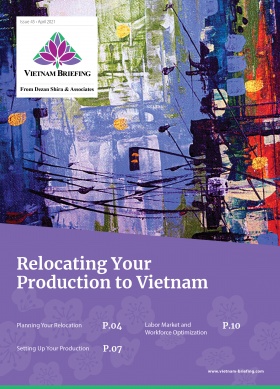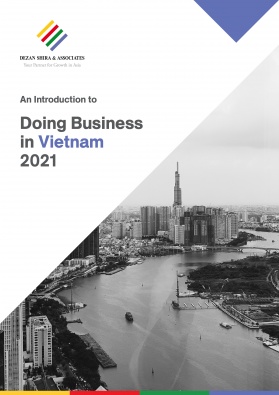4 Factors to Consider When Relocating Your Production
- With several investors moving or diversifying their production, choosing an alternate production base may be challenging especially during a pandemic.
- Investors should therefore do a thorough due diligence and ensure that they are well prepared before relocating their production.
- Vietnam Briefing employs our Business Intelligence services to highlight important factors when choosing to relocate or diversify your manufacturing operations.
Vietnam is experiencing continued and unprecedented growth relative to other low-cost countries. Foreign investors are increasingly choosing Vietnam as a China plus one destination to combat rising costs in China and other unpredictable scenarios, such as trade shocks.
This strategy has acquired new value amid the US-China trade war and most recently, the COVID-19 outbreak, which have both impacted manufacturers in China and their supplies to global markets. Such events are not entirely unforeseen but have a global fallout. Naturally, it makes sense that investors diversify to better manage their risks.
In this context, foreign investors are choosing to supplement Chinese operations with low-cost inputs sourced from production facilities in alternate markets, such as Vietnam. In addition to its geographic proximity to China, Vietnam offers several advantages for manufacturers planning to move outside China.
To make an informed decision, Vietnam Briefing introduces our Business Intelligence (BI) service, which is a critical component in the decision-making process when considering and planning your relocation to countries such as Vietnam. While investors are highly advised to use a professional service for such a decision, we highlight the major factors tailored by our BI services team to help make an informed decision when planning a relocation.
Choosing the right location
Countries like Vietnam are not without their share of challenges. In the short term, manufacturers may find the production shift daunting as supply chains have to realign. Companies often struggle to decide what to relocate, how they plan to enter the Vietnamese market, and where they will establish operations within the country.
Choosing a location can be particularly challenging as the factors affecting site selection are rapidly changing. Everything from labor costs, logistics, customs practices, and infrastructure in emerging markets such as Vietnam is constantly evolving.
Location analysis and a strategic site selection plan can have a major impact on the success of a business, affecting production, operations, and sales. Companies must take steps to ensure they have the right information before committing time and money.
Identify Where to Relocate Your Supply Chain in Asia with Data-Driven Analysis
Get the key information necessary to make a location decision with data to support it. A benchmark report evaluates a short-list of locations side-by-side so you can make the best decision for your business.
For example, Vietnam enjoys a high degree of regional diversity, and the North, Center, and South all have particular competitive advantages for different industries and types of businesses. In the Ho Chi Minh City area, a prospective investor will find a vibrant commercial center with a deep and diversified supply chain, whereas the Center of the country can provide cost advantages unmatched by either the North or the South.
Vietnam’s northern provinces are well-positioned as a destination for China+1 manufacturing and oil and gas, and more recently for high-end manufacturing processes, such as auto manufacturing.
Several factors should be taken into account when selecting a location. These include:
- Human resources (HR);
- Real estate;
- Infrastructure;
- Costs;
- Operating environment;
- Proximity to suppliers and the customer market;
- Legal and regulatory environment; and
- Operating environment.
These factors will allow the investor the ability to better understand their options in new markets and make informed decisions on where to invest.
Labor availability
In the current framework, as countries such as Vietnam develop into a prominent regional manufacturing hub, companies entering the market need to consider workforce availability and implement appropriate HR strategies to source an appropriate workforce as well as attract and retain the best talent.
Vietnam has a population of over 97 million people spread over 330,000 square kilometers. The country is still predominately rural, with urban centers providing a home for just 35 percent of the population. Companies entering Vietnam for the first time often fail to account for regional variation in the labor market and invest in locations ill-suited to their industry.
Investors that take the time to explore Vietnam’s provinces will find opportunities to manage costs while maintaining productivity. Executives will benefit from understanding the cost differential between different provinces in Vietnam, but the real beneficiaries of a regional approach will be HR departments and hiring managers. HR departments that understand what Vietnam has to offer will be much better positioned to recruit, onboard, and, where necessary, train new workers.
Vietnam’s southern labor pools are more diversified than their northern counterparts. Investment in services and a wider range of manufacturing provides access to more niche talents than in the north. Competition and recruitment demand in southern provinces are higher when compared to the northern and central provinces.
Regulatory environment
The regulatory environment encompasses several factors: political environment, policies, environment laws, the complexity of regulations, etc. Depending on the industry this can range from administrative procedures, permits, fees, taxes, and time needed to set up a factory.
While Vietnam’s gradually improving regulatory environment has made operating businesses easier, Vietnam is not without its share of challenges. Vietnam’s regulatory regimes and commercial law, and the overlapping jurisdictions of some government ministries, can result in a lack of consistency in government policies. There are also poor corporate disclosure standards and a lack of financial transparency, which can add to due diligence and KYC challenges.
Competitive analysis
The final consideration companies should consider is a competitive analysis comparing several countries or geographical areas. This involves cross-referencing and benchmarking several factors such as:
- Political climate;
- Economic environment;
- Regulatory landscape;
- Cost analysis – this includes utilities, land rentals, etc;
- Labor – includes wages, educational qualifications, and skill levels; and
- Taxes – Duties, corporate taxes, personal taxes, among others.
Doing such a thorough review will ensure the investor can make an informed decision when relocating their production to countries such as Vietnam. This will also enable the investor to see the strengths and weaknesses of each country that is benchmarked. For example, some locations may be ideal production destinations for certain industries due to costs, labor, and regulations, while another location may be better for its political climate, stable government, and attractive tax schemes.
However, it’s important to note that each relocation or investment project requires a tailored approach. While these are general guidelines, our BI services can advise foreign investors in the decision-making processing when considering where and how an investment in Asia should be made.
Request a tailored benchmark report for your relocation.
About Us
Vietnam Briefing is produced by Dezan Shira & Associates. The firm assists foreign investors throughout Asia from offices across the world, including in Hanoi, Ho Chi Minh City, and Da Nang. Readers may write to vietnam@dezshira.com for more support on doing business in Vietnam.
We also maintain offices or have alliance partners assisting foreign investors in Indonesia, India, Singapore, The Philippines, Malaysia, Thailand, Italy, Germany, and the United States, in addition to practices in Bangladesh and Russia.
- Previous Article Relocating Your Production to Vietnam – Latest Issue of Vietnam Briefing Magazine
- Next Article Vietnam – Belgium Relations: Increasing Trade and Opportunities for Investors







